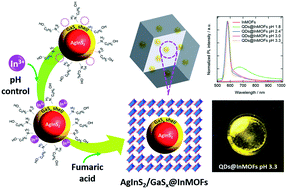Encapsulation of AgInS2/GaSx core/shell quantum dots in In-fumarate metal–organic frameworks for stability enhancement†
Abstract
Silver indium sulfide/gallium sulfide (AgInS2/GaSx) core/shell quantum dots (QDs), among the cadmium-free alternatives that possess a narrow band-edge emission, have attracted immense attention in recent years. However, the insufficient stability of photoluminescence (PL) due to chemically sensitive GaSx shells, which is partly caused by easy desorption of passivated ligands, remained a problem for their practical application. In this study, a simple and efficient method to protect these QDs is presented. The AgInS2/GaSx core/shell QDs are encapsulated into metal–organic frameworks (MOFs) consisting of an indium-fumarate ordered structure (InMOFs). Whereas damage to the shell during the encapsulation reaction can potentially occur, the obtained composite (AgInS2/GaSx@InMOFs) maintains a narrow band-edge emission that is mostly identical to the pristine AgInS2/GaSx core/shell QDs with a PL quantum yield (PL QY) of 12.6% after optimization of the synthesis-solution pH. The encapsulation result enables the spectral shape and PL QY of the composite to be maintained after 7 days, which demonstrates the high stability of the QDs encapsulated in InMOFs.



 Please wait while we load your content...
Please wait while we load your content...